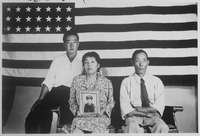Camp Livingston
Coordinates: 31°26′39″N 92°21′44″W / 31.444244°N 92.362232°W Camp Livingston was a U.S. Army military camp during World War II located on the Rapides Parish and Grant Parish line in north Louisiana, 12 mi (19 km) north of Alexandria, Louisiana,[1][2] north of Pineville, Louisiana.
History
Camp Livingston was open from 1940 to 1945 and was first known as Camp Tioga.[2] It was renamed Camp Livingston in honor of Chancellor Robert R. Livingston, a negotiator of the Louisiana Purchase and the brother of Edward Livingston, a US Senator and later the country's Secretary of State.[2] It was home to many divisions (see List, below) and others during the war. In 1941 there was an aviation squadron of 250 African American men in the Army Air Corps performing service function.
Camp Livingston was designated as an infantry replacement training center, as well as a garrison for these infantry divisions. The 38th Division was known as the "Avengers of Bataan" and the 86th Division was the first American unit to cross the Danube River into Germany. Over 500,000 troops trained on the 47,000-acre (190 km2) base during the war. On some old concrete walls in the site, beautiful artwork and graffiti has been discovered and is thought to have been drawn by Italian POWs.
In 1941, prior to the United States declaring war, the camp was part of the Louisiana Maneuvers, a 400,000-man training exercise involving two imaginary countries fighting each other. The two armies faced each other across the Red River, over 3,400 square miles (8,800 km2) of land, including part of East Texas.
During World War II, thousands of Japanese, German and Italian prisoners of war were kept in internment camps at Camp Livingston and Camp Claiborne. In 1942, the war's first Japanese POW Kazuo Sakamaki arrived at Camp Livingston. Sakamaki was the only surviving crewman of a mini-submarine used in the attack on Pearl Harbor; he was captured by Corporal David Akui after abandoning his sub, which had run aground. The internees at the camps were used to supply logging and farm labor in the area. There was a POW cemetery located within Camp Livingston and in 1947 the headstones were relocated to Fort Sam Houston and the bodies of the POWs were left in the ground unmarked where they remain today.
The camp also held between 800[3] and 1,100[4] US civilians of Japanese ancestry who were interned as potential fifth columnists after Pearl Harbor. Most of these men remained in confinement throughout the war, despite a lack of evidence to prove they posed a threat to homefront security.
Camp Livingston was deactivated in late 1945 and is now part of the Kisatchie National Forest.[5][6][7][1]
Today
The US Forest Service manages the property where the camp was previously located, and most of the original concrete streets can be accessed and some are used on a daily basis for traffic passing through the camp. The footings from many of the buildings are still in place as well as most of the original parking lots and parade areas. At least two of the swimming pools can be located and one of those up until recent years was used as an unauthorized civilian shooting range. The US Forest Service also maintains the Little Creek and Hickman Trails, which are multiple-use trail systems utilized by ATV enthusiasts throughout the area. The original water treatment plant that was built to serve the camp is still in operation today, and now is operated by Water Works District No. 3 in Rapides Parish.
List of units stationed at Camp Livingston
- 28th Infantry Division[2]
- 32nd Infantry Division[2]
- 38th Infantry Division[2]
- 86th Infantry Division[2]
- 327th Military Police Escort Guard
- 93rd Engineer General Service Regiment
- 7th Transportation Battalion
- 240th Quartermaster Battalion
- 846th Tank Destroyer Battalion
- 46th Field Artillery Brigade
- 350th Field Artillery Group
- 351st Field Artillery Group
- 353rd Field Artillery Group
- 1692nd Engineer Combat Battalion
- 1693rd Engineer Combat Battalion
- 1694th Engineer Combat Battalions
- 527th Antiaircraft Artillery Automatic Weapons Battalion
- 510th Ordnance, Heavy Mechanized Field Artillery Company
References
- 1 2 "Our Places, Our Heritage: A Plan for Historic Preservation and Archaeological Conservation in Louisiana, 2011–2015" (PDF). Louisiana Office Of Cultural Development. January 2011. p. 11. Retrieved June 22, 2016.
- 1 2 3 4 5 6 7 "Camp Livingston Louisiana". alexandria-louisiana.com. Retrieved June 22, 2016.
- ↑ Burton, J.; Farrell, M.; Lord, F.; Lord, R. "Chapter 17: Department of Justice and U.S. Army Facilities". Confinement and Ethnicity: An Overview of World War II Japanese American Relocation Sites. National Park Service. Archived from the original on April 14, 2015. Retrieved June 22, 2016.
- ↑ "Camp Livingston". Densho Encyclopedia. Retrieved 11 June 2014.
- ↑ "Louisiana's Military Heritage: Forts, Camps, and Bases". USS Kidd Veterans Memorial. Archived from the original on December 12, 2012. Retrieved June 22, 2016.
- ↑ "Grant Parish Tidbits". thetowntalk.com.
- ↑ "Camp Livingston Louisiana". WinnFreeNet.com. Retrieved June 22, 2016.
External links
| Wikimedia Commons has media related to Camp Livingston. |
- "Camp Livingston Louisiana". WinnFreeNet.com.
- Kisatchie National Forest at US Forest Service
